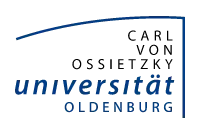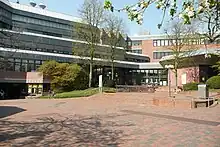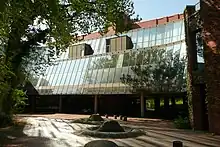University of Oldenburg
The Carl von Ossietzky University of Oldenburg (German: Carl von Ossietzky Universität Oldenburg) is a university located in Oldenburg, Germany. It is one of the most important and highly regarded educational facilities in northwestern Germany and specialises in interdisciplinary and sustainable development studies and renewable energy studies with focus on solar and wind energy.
Carl von Ossietzky Universität Oldenburg | |
 | |
| Motto | Offen für neue Wege |
|---|---|
Motto in English | Open for new ways |
| Type | Public |
| Established | 1973 |
| Budget | €224.3 million[1] |
| President | Ralph Bruder[2] |
Academic staff | 1,459[1] |
Administrative staff | 1,037[1] |
| Students | 15,220[1] |
| Location | , , Germany 53°08′52″N 8°10′56″E |
| Campus | Urban |
| Affiliations | EUA |
| Website | uni-oldenburg.de |

History
The first teachers training was held in Oldenburg as early as 1793, launched by Duke Peter Friedrich Ludwig. A garden seminar for teachers training was created in 1882. During the Weimar Republic, the establishment of the Pedagogical Academy (Pädagogische Akademie) in Oldenburg in 1929 enabled the vocational training of teachers. On 1 October 1945, the institution reopened in postwar Germany. In 1948 it was renamed the Pedagogical College Oldenburg (Pädagogische Hochschule Oldenburg).
The first step towards the university was taken on 23 February 1959 with the decision of the city council to launch a university project, which was followed in 1970 with the Memorandum establishing the University of Oldenburg from the Minister of Culture of Lower Saxony. The university was finally founded in 1973. Enrollment and teaching started in the summer semester of 1974, with an education curriculum for 2,400 students. In 1991, the university was officially named after pacifist, writer and Nobel laureate Carl von Ossietzky, having been denied to take on his name by previous (both left-leaning and right-leaning) state governments.[3] That same year, the number of students passed the mark of 10,000. The eleven departments of the university were reorganized into five faculties in 2002. By the end of 2011, there were about 11,325 students.
In 2012, the university founded the faculty of medicine and health sciences, introducing a 12-semester course in human medicine, which leads up to the German state examination, Staatsexamen, a prerequisite to practice as a physician. The new faculty is part of the European Medical School Oldenburg-Groningen (EMS), a cooperation between the University of Oldenburg, the University of Groningen (Netherlands), and local hospitals.[4]
University Profile


The university offers 95 courses of study. Due to the Bologna Process, in 2004 Oldenburg adopted Bachelor and Masters degrees in place of the former Diplom and Magister. One main focus of the university is teacher training, which was established during the 1970s and remains a strong presence with master's degrees in teaching offered in all faculties. The PhD program Didactical reconstruction is especially renowned, as is the research in sustainable development, encompassing several academic disciplines. The university is also allowed to confer Doctorates and oversee Habilitations.
The campus is split into two locations, the major one being Uhlhornsweg, where the main library, the mensa and the administration along with most of the departments is housed. Having used the buildings of the former teaching college during the first years, the main buildings of the university were inaugurated in 1982, with ongoing extensions since then, including the main lecture hall in 2001. The Wechloy campus, also first opened in 1982, is home to the studies of natural sciences as well as the library of natural sciences.
A primary theme guiding the university research is Environment and Sustainability, which integrates natural and social sciences as well as sociology to create innovative solutions for responsible and efficient resource use. This includes biodiversity, marine sciences, future energies, and sustainability.
In Biodiversity and Marine Science, the university leverages its Institutes of Biology and Environmental Sciences (IBU) and Chemistry and Biology of the Marine Environment (ICBM). The research covers a range of scales, from molecular to global, examining the adaptive capacities of organisms to varying environmental conditions and the dynamics of biodiversity in the face of rapid global change. The university also conducts extensive marine research, including an analysis of the Wadden Sea and ocean research through the research vessel “Sonne".
The university is also known for its long-standing, internationally recognized energy research for over 30 years. This research involves two clusters: Materials and Systems and Networks. The Materials cluster explores fundamental energy conversion processes and their quantum dynamics in nanostructures. In contrast, the Systems and Networks cluster focuses on networking energy system components, technologies, materials, and models into large-scale systems.
Sustainability is another core research area at Oldenburg, emphasizing the societal challenges emerging from changes in human behavior, nature, and technology. Sustainability research includes coastal areas, climate and society, human-nature-technology interactions, and integrative systems analysis. This research is anchored in various university institutes and faculties and supported by several local and international funding bodies.
In Hearing Research, the university seeks to develop solutions for hearing loss through its “Hearing4All 2.0” program and the “Hearing Acoustics: Perceptive Principles, Algorithms and Applications" project. Collaborations with external partners like Hörzentrum Oldenburg GmbH and Fraunhofer IDMT enrich the research landscape.
The Cooperative Critical Systems research focuses on developing safe, secure, and user-friendly embedded systems, particularly for transportation. Significant projects include the Graduate School (GRK SCARE) and a transatlantic collaborative research project funded by DFG and NSF.
Sensory Neuroscience research investigates the function of neural networks and their relation to perception and cognition. Supported by cutting-edge technologies, ongoing projects like the "Molecular Basis of Sensory Biology" and "Cryptochrome-based magnetic sensing" contribute to this field. Future plans involve intensified collaboration with the "Human Cyber-Physical Systems" research center.
As part of the Universities Excellence Initiative, the university was awarded a Cluster of Excellence for its initiative Hearing4all. The cluster deals with research into the improvement of speech understanding in background noise and has a funding of €34 million.[5]
Departments
- Faculty I: Pedagogy and Education
- Institute of Education
- Institute of Special Education and Rehabilitation Paedagogy
- Institute of Social Sciences
- Faculty II: Computer sciences, Law and Economics
- Department of Computer science
- Department of Economics and Law
- Faculty III: Linguistics and Cultural studies
- Institute of English and American Studies
- Institute of German Studies
- Department of Dutch Studies
- Institute of Slavic Studies
- Institute of Art and Visual Culture
- Institute of Material Culture
- Department of Music
- Faculty IV: Social Sciences
- Institute of History
- Institute of Protestant Theology
- Institute of Philosophy
- Institute of Sports Science
- Faculty V: Mathematics and Natural Sciences
- Institute of Biology and Environmental Sciences (IBU)
- Institute of Chemistry
- Institute of Physics
- Institute of Mathematics
- Institute for Chemistry and Biology of the Marine Environment (ICBM)
- Faculty VI: Medicine and Health Sciences
- Department of Psychology
Cultural and political life
The Studentenwerk of the University organizes the cultural bureau UNICUM and the theatre since 1985. UNICUM includes theatrical groups from the university as well as freelancers. The group Gegenlicht runs a cinema in the Old Aula and on campus during the summer, while the programme zwergWERK is focused on the presentation of short films.
As in other German universities, the AStA is the most important organ of student representation. It administers the public transport tickets for the student body, offers several forms of student loans and organizes festivities. In addition, the AStA is continually involved in campaigns concerning university policy and social activism.
Canteens
The Studentenwerk Oldenburg operates canteens both the Uhlhornsweg and the Wechloy campus. These are certified by the BIO seal since January 2004. In the main cafeteria at Uhlhornsweg, four different dishes are available every day, as well as side dishes. In addition, different pasta is served daily, and a selection of high quality, self-composable, courts, at slightly higher prices, is available at the Culinarium.
In 2001, the cafeteria at Uhlhornsweg took first place in the taste category and ended up in second place overall at the German-wide canteen ranking done by UNICUM magazine. The following years, it steadily dropped, but in 2008, it managed to return to second place overall, and again become first ranked in the taste category.[6]
In addition to the canteens, the Studentenwerk operates a large cafeteria on Uhlhornsweg campus. In Wechloy, canteen and cafeteria are combined in the same area.
International partnerships
The first major cross-border cooperation was started in 1980 with the Rijksuniversiteit Groningen. It has since then resulted in an especially far-reaching partnership, with several majors jointly offered by the two universities.
The university participates in the ERASMUS programme, a partnership for student exchanges in Europe. It maintains cooperation agreements with 105 universities in 44 countries.[7][8]
Awards
- The annual Klaus-von-Klitzing Award is jointly awarded by the university and the EWE-Foundation for special commitment in the teaching of natural sciences. Out of the 15.000 Euro prize money, 10.000 have to be invested into a teaching project. It is named for the German Nobel laureate Klaus von Klitzing.
- Also annually during each Tag der Chemie (Chemistry Day), the Angelus-Sala Award is award to the high school students of the region who excelled in chemistry class. It is named for the physician and natural scientist Angelus Sala.
Notable faculty and alumni
- Prodosh Aich (born 1933), indologist
- Hans-Jürgen Appelrath, professor of computer science and information technology
- Jürgen Gmehling, professor of technical and industrial chemistry
- Bettina Meyer, professor, Antarctic researcher
- Niko Paech, economist, substitute professor
- Viktoria Schmidt-Linsenhoff (1944–2013), German art historian and professor
- Björn Thümler (born 1970), German politician
See also
References
- "Zahlen und Fakten" (in German). University of Oldenburg. Retrieved 11 July 2017.
- "Präsidium" (in German). Carl von Ossietzky Universität Oldenburg. 30 March 2021. Retrieved 15 September 2021.
- Vinocur, John (31 March 1982). "WEST GERMAN UNIVERSITIES: WHAT TO CALL THEM?". The New York Times. ISSN 0362-4331. Retrieved 12 February 2023.
- "European Medical School Oldenburg-Groningen". University of Oldenburg. Retrieved 23 January 2013.
- "Exzellenzinitiative für Spitzenforschung an Hochschulen". Federal Ministry of Education and Research (Germany). Retrieved 23 January 2013.
- "Mensa des Jahres 2008". UNICUM Mensa des Jahres. Archived from the original on 24 May 2011. Retrieved 23 January 2013.
- "Partneruniversitäten der Universität Oldenburg". University of Oldenburg. Retrieved 23 January 2013.
- "Erasmus+ at a glance". University of Oldenburg. Retrieved 4 August 2023.
External links
- Official website (in English)
- The University's International InfoPortal (in English)
- Information about the university's networking opportunities for internationals (in English)
- Oldenburg Student Services (in German)
- Official Website of the University's students representation
- Official Website of the University's students parlament